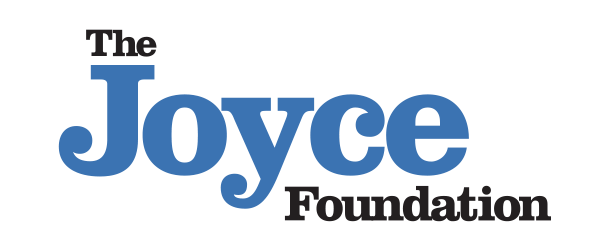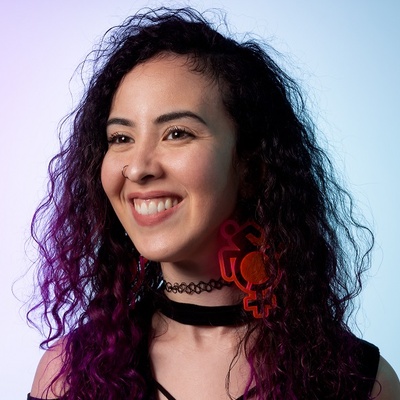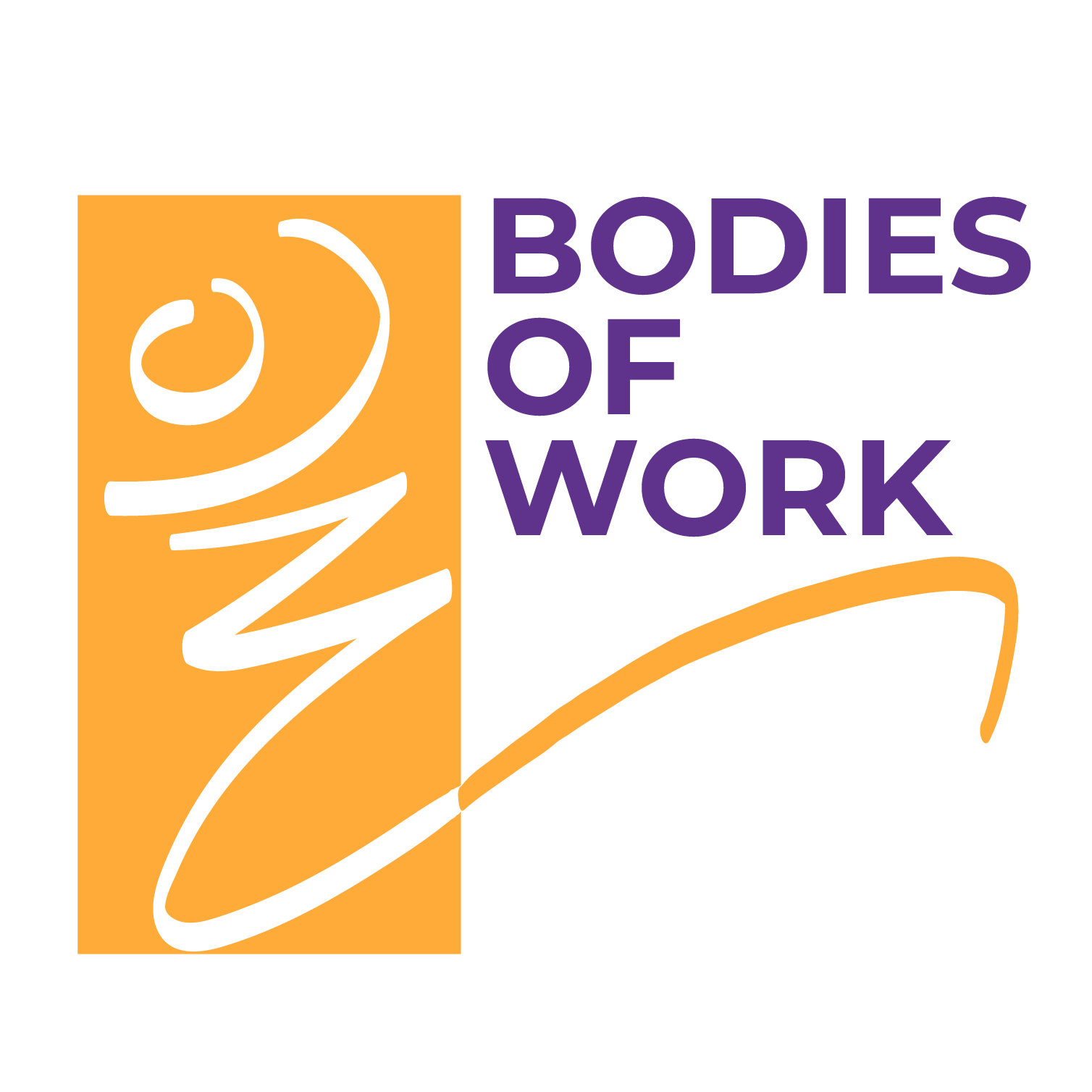Beauty and Power
Fall 2022
Anita Gonzalez, a writer, director, and professor at Georgetown University, leads a conversation with Genevieve Ramos, a Mexican-American painter and disability advocate, and Grishma Shah, a South Asian visual artist, producer, and entertainment community psychologist. The artists discuss their art and its themes of femininity, empowerment, political awareness, and cultural identity.
This is a transcript of the closed captions from the video conversation.
Anita Gonzalez: Hi, my name is Anita Gonzalez, and I'm a writer, director, and educator. I'm also a professor of Performing Arts and African American Studies at Georgetown University and a co-founder leader of their Racial Justice Institute. Today, I'm in conversation with two artists who have participated in the 3Arts/Bodies of Work Residency Fellowships. This is part of a series of conversations designed to promote the art of Deaf and disabled artists and their experiences in the disability culture community.
Genevieve Ramos is a Mexican-American painter and disability advocate. She is inspired by beauty, positivity, and love of the world. Her art uses bright color and focuses on themes of femininity, empowerment, and political awareness.
I also have Grishma Shah, who's a South Asian visual artist, producer, and entertainment community psychologist. Her objective is to bring out beauty where it has been forgotten so it can be noticed again. As a visual artist, Grishma infuses heritage and components of mixed media into her works to create 3D-like paintings.
Welcome to both of you.
Grishma Shah: Thank you so much.
Genevieve Ramos: Hello, thank you so much.
Anita Gonzalez: So we're going to begin with a very simple question, which is I'm gonna ask you to take a moment to describe your art. I want to know what drives you creatively, what's important to you and your work as an artist. Those are the kinds of things we'd like to share with our audiences today.
Grishma Shah: I think for me, there's a lot of anger, you know, that I'm trying to transform and put in my art. Just growing up and being in this world, I've noticed that the world is more than fair to a certain group of people and less than fair to a certain group of people. And I just feel like what can I do as an individual to make it more equitable for folks like myself who, you know, have so many multiple identities intersecting each other, but also for folks that are from different communities. I think we all have these universal needs of, you know, wanting to be loved, wanting to love, and wanting to live our best lives.
Anita Gonzalez: Thank you for that. How about you, Genevieve?
Genevieve Ramos: I like to describe my work as my heart on a canvas. I really use my art as a vessel to pour out the experiences I face and the experiences others face with similar identities. I like to inspire hope and show the world the beauty that's so a part of us. I'm very inspired by my mom's Mexican culture, and I love bright colors, textures, and movement.
Anita Gonzalez: Are there particular aspects of Mexican identity that your mother gave to you that you see in your artwork?
Genevieve Ramos: Oh, definitely. My mom grew up where my grandmother was the leader in the house, a matriarchy. So that woman empowerment stems from a very bold grandmother who raised my mom, and my mom would kind of give me those lessons to be who I am unapologetically.
Anita Gonzalez: Grishma, how does cultural identity figure into the work that you do?
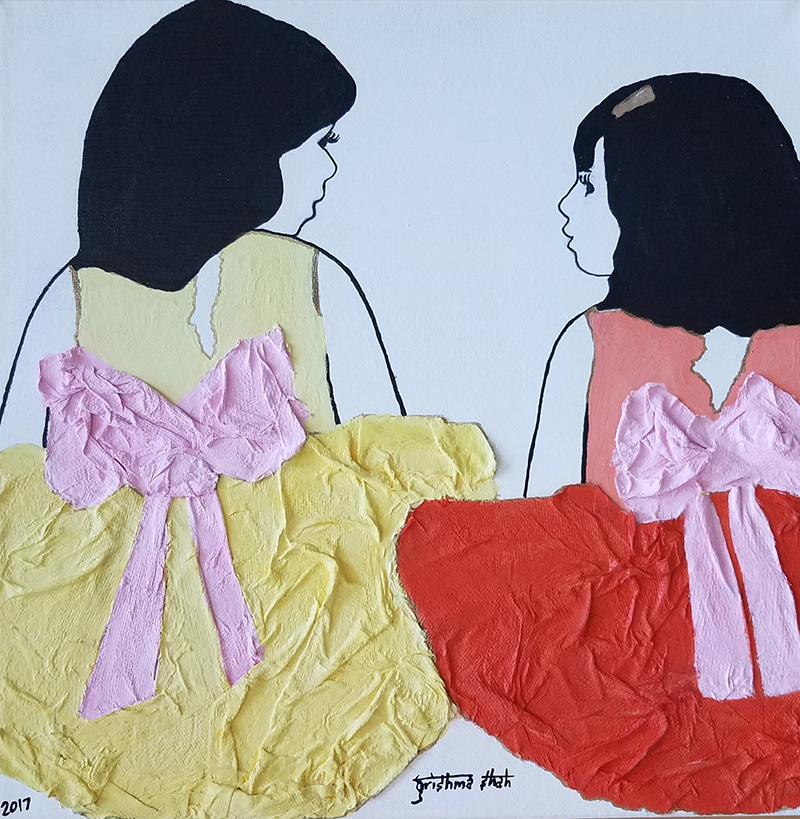 Childhood Moments by Grishma Shah
Childhood Moments by Grishma Shah
Grishma Shah: Growing up, you know, I'm one of two girls. And if you think I'm beautiful, you should see my sister [laughs]. Her nickname was Dolly because she very much looked like a doll growing up, and even now she's got like that fair skin, she's got, you know, colored eyes, she's got like that brownish hair, and then you look at me and I'm, you know, on the darker side. I could be pale, but I'd rather not be pale because that means I'm anemic [laughs].
And I remember me telling my mom like, "Mom, you know, am I beautiful?" And my mom's like, "Of course you're beautiful." And she's like, "Look at Kali." Kali is one of the Hindu gods and she's like this badass warrior, and she has beautiful hues of blue and black. And I was like, "Yeah, Kali is gorgeous, but why is it that when I look at Kali I see her beauty, but then when I look at myself I don't feel beautiful, you know, I feel like, oh Genevieve is beautiful, she's got that fair skin, doll-like features that I grew up learning are qualities of beauty."
So I'm trying to, you know, add that into my art and add more colors, more brown tones, darker tones. And then the other thing that I'm really having a great time doing is with henna. You know, growing up, henna was like this thing where you saw brides have all of these henna designs on their hands. And I would always ask like, "Why aren't the boys putting on henna?" And they're like, "No, no, it's a thing that women do." And it just struck me like, "You know, why is that?"
Perhaps it's because in many cultures you want the woman to be as beautiful as possible because that is where her worth comes from. And in a lot of cultures, for men it's more their intelligence, right? And so, I just, I will put henna on everyone in anything because I just think it's absolutely beautiful and it should be universal for everyone.
Anita Gonzalez: I wanted to ask you how, drawing upon your experiences, you can explain how your work relates to disability aesthetics.
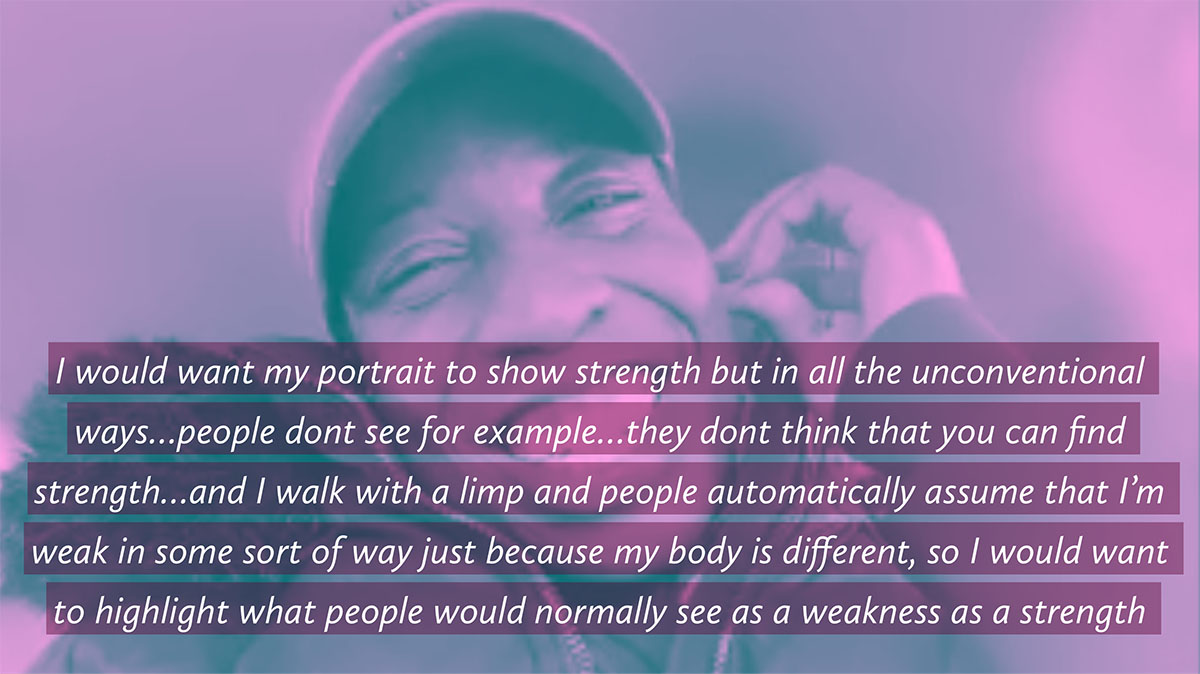 Image by Genevieve Ramos
Image by Genevieve Ramos
Genevieve Ramos: So, in my work with the [3Arts/Bodies of Work] fellowship, I'm focusing on portraits of disabled women of color who are leaders in the community. And I think highlighting them through portraiture is everything and more of disability aesthetics. It's a love letter to the community to really look at these beautiful portraits and see who these women are and what they do. There's so much beauty and power in highlighting them through portraits, and I feel so honored that I can give that gift to viewers.
Anita Gonzalez: That's beautiful. We all need a love letter [laughs]. I'll tell you, love letters and beauty, that's the theme here. Go ahead, Grishma.
Grishma Shah: It's the disability community that at first I felt really hesitant to be a part of because my culture and other cultures, they don't, um, have a really good perception of what it means to be disabled. But coming to this disability community through 3Arts and Bodies of Work, I've realized that it's so beautiful. You've got people that accept you right at the very beginning. You don't need to prove yourself, you know, they recognize your worth as a human being. And it's just, you can be yourself and come as your full self. And I haven't really experienced that in too many places.
And so I think it's an honor when Genevieve talks about these portraits of disabled women coming as their full selves, so the whole world can see them as they really are.
Grishma Shah: It just reminds me again that so much of the world has forgotten about what beauty really looks like, and it's up to us artists, you know, to be able to share that.
Anita Gonzalez: I'm going to now ask Genevieve if she could talk a little bit about what it means to you to be a part of a disability community.
.jpg) Photoshoot featuring Reveca Torres and Genevieve Ramos
Photoshoot featuring Reveca Torres and Genevieve Ramos
Genevieve Ramos: I'm really speechless because what this community has given me, it's such a gift. I feel celebrated for exactly who I am, in community. It's what had me motivated to pursue art. I began with Access Living many, many years ago, after I acquired my disability, and the people I met were so warm, so beautiful, so loving. It's really the groundwork for humanity, I really feel, with the way we love and care. I hope it can blossom into all communities.
Anita Gonzalez: That's wonderful, it's like networks of care coming from communities that value you for who you are, that has so much healing power within it. So it's wonderful to know that the fellowship has created that space for the two of you.
I'm wondering because you're both visual artists, have you had challenges in gaining access, funding, or training in your art form, or in your field?
Genevieve Ramos: I definitely feel like the art world is kind of snobby. [Laughter.] And competitive.
Genevieve Ramos: I feel so lucky to be a part of the disability arts and culture community in Chicago because it's not about competition, it's about collaboration and creating something bigger than ourselves. I feel very fortunate. I have a support, a network that even when I do face any discrimination for accommodations, for example, for art classes, I need help with my mobility issues, but I always found a way to get everything I need.
Grishma Shah: I have a thought about that, if that's okay.
Anita Gonzalez: Sure!
Grishma Shah: So you know, Genevieve, when you were talking about like the art community being snobby and competitive, I started laughing because you're so right, um, but at the same time, I think it's that competitiveness, right, that really drives us to want to do our best work. But if I hear that like, you know, I didn't get an opportunity, my first thought is, well, I hope somebody that I really support gets it. That's something in the disability community that I don't see outside as much, and it's very beautiful if you really think about it.
Anita Gonzalez: What she also talked about was how she views the community as allowing her to be collaborative in her art-making process. Because usually we think of visual artists as solo artists working alone in their studio, but both of you have talked so wonderfully about how the community allows the making of art to be a collaborative process that's not individualistic, because you're supporting one another in your work. That's beautiful stuff.
Grishma Shah: And I think it goes back to, and Genevieve please chime in, it goes back to how we think art should be, right? Most of the time we think art should be visual, right, but what about sensory, what about all of the other senses that come together, or you can take them apart? The same story that I tell can be very different visually or can be danced very differently.
Grishma Shah:I think it's so important that we do collaborate because that's only when the whole beauty of a story can come out for the disability community.
Genevieve Ramos: I don't know how I feel about being a visual artist. My art... I feel visual art is restrictive. I want my art to reach everyone.
Grishma Shah: Yeah, I did that for the exhibit I was talking about, "A South Asian Perspective," where, like, if you close your eyes and you touch the artwork, you could feel fabric and you can feel the bindi, and you can feel other things. Yeah, I know a lot of artists are like 'don't touch the artwork,' and I'm like go ahead, touch the artwork. It's been sealed, it's fine [laughs].
Anita Gonzalez: I wonder if you have a question for one another.
Genevieve Ramos: Well, I'm a fan of Grishma. She's a fireball. She's very fire-y, and her energy is just very resonant in her work. And I appreciate the darkness within your work. Can you elaborate more on that?
Grishma Shah: I use art as a way to transform my frustration. I will one hundred percent say that art has saved me. You know, every time I have felt like I'm not, I don't feel like I belong, I don't feel like I'm welcomed for who I am, I turn to art, and I try to, um, almost like push that frustrative energy into the artwork. And I think that's why it's on the darker side. And I'm starting to see so much beauty in it. If you look hard enough in my artwork, you'll notice that, like, not all limbs are there, or certain things are looking differently. I have this one painting called "Canvas," and a lot of people think that it's very beautiful. I think you've seen it as well, Genevieve. And then, after they say that, "Oh, it's very beautiful. It's one of my favorite works of yours," I say, "Have you noticed that there's a thumb missing? Have you noticed that that second finger, um, you know, may not be a full finger?" And it takes them a moment to go, "Oh." And then I ask them, "Do you still find that it's beautiful?" And there's like a bit of like... 'uh, yeah, it's still beautiful, but it's difficult for me to kind of put together, that disability and beauty can go together,' and these are the conversations that I want to have because, why can't they? Why can't they?
.jpg) Canvas by Grishma Shah
Canvas by Grishma Shah
Anita Gonzalez: And do you have a question, Grishma, for Genevieve?
Grishma Shah: I have so many questions for Genevieve, um, but I guess my main question is how do you make it out of love? My goal has been to share the message of love, but I feel like it starts out as frustration.
Genevieve Ramos: I could be naive and very big hearted. I see love... I see the good in everything. I'm an idealist to a tee. I mean, I do go to dark places, often. You're not alone in that, trust me. But I just try to transmute the darkness into light. And I do a lot of soul searching, a lot of healing, a lot of acceptance, of forgiveness of whatever hurt me or what hurt goes around me or hurts my community. And the opposite of fear is love.
Grishma Shah: You're right, you know, like even when we're painting, right? If we don't highlight the shadows, everything looks very flat. Yeah, so you're right, the dark and the light are two very beautiful components, and for some reason we've just been taught that dark is bad and light is beautiful, when the reality is it's both as beautiful in its own way.
Genevieve Ramos: Yeah, and they work together.
Grishma Shah: They work together, like a collaboration [laughs].
Genevieve Ramos: Like disability and beauty.
Grishma Shah: Like disability and beauty. Yeah, yeah. Here's two beautiful examples, right? We're both disabled, and we're both beautiful.
Genevieve Ramos: And strong.
Anita Gonzalez: And strong. You guys are really inspiring me. It makes me want to know what's next for you? What are you guys dreaming about for your own practices or for the disability arts movement?
Genevieve Ramos: I'm kind of at a strange part of my life where I used to always have a plan, used to always have a Five-Year Plan. And it's been, okay, this year I'm gonna do this. I'm gonna move this. I always had a vision of what I wanted, and this is the first time in my life where I'm like, I'm gonna let it flow. I'm gonna be in community, I'm gonna love and care for myself and for others, and just let... let my higher power lead the way.
Anita Gonzalez: It's like the Five-Year Plan now gives way to whatever inspires you next. How about you, Grishma?
Grishma Shah: I honestly feel like I have so much to catch up on. I was on chemo for like 16 years, and I feel like I've just lost so much time. And I feel like if I just double the work, you know, then maybe I could catch up where everyone else is. But I realize that in itself is an experience that I need to honor, and I need to honor it in my own body, in my own space, and let my higher self lead the way, which is hard.
Anita Gonzalez: I think this has been really, as I said, inspirational for me, especially thinking about how you can take the art practice to wider communities. But also about this contrast between identity and light and dark, about how one finds hope and also one finds frustration in the works that we do, and that you can always express it through art. I want to ask each of you, is there any one last thing that you'd like to say?
Grishma Shah: I feel like stories teach us about who gets worthy of love and who gets worthy of hate, and so if we can just make sure that these stories are authentic and they're sharing some very universal experiences, I think it'll make a better world.
Anita Gonzalez: How about you, Genevieve, do you have any final words?
Genevieve Ramos: I want to piggyback on Grishma. Stories are how feminism began in the 60s. Even those stories were being taught, for generations back, but that's how we heal. That's how we stand together and change, and change the narrative that's damaging our communities. When we all can be together and share these stories and know we're not alone in our experiences and our fight to change.
Grishma Shah: Yeah, in my own work, I definitely promote people telling stories because there are so many missing. There are so many stories missing.
Anita Gonzalez: I'm really grateful for the two of you for sharing those stories through visual arts but also through your activism. Both of you are activists in your own ways and how you promote the work that you're doing and how you collaborate and promote with other artists. So I want to thank you so much for being with me today and keep doing the work that you're doing!
Genevieve Ramos: Thank you, Anita, and thank you to 3Arts.
Grishma Shah: Thank you for 3Arts and Bodies of Work.
The Disability Culture Leadership Initiative and 3Arts/Bodies of Work Residency Program are supported in part by grants from
the Joyce Foundation and the National Endowment for the Arts.
